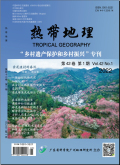热带地理2024,Vol.44Issue(1):79-91,13.DOI:10.13284/j.cnki.rddl.003811
中国县域数字乡村发展的空间格局及驱动因素研究
Research on Assessing the Spatial Pattern and Driving Factors behind of the Development of County-Level Digital Countryside in China
摘要
Abstract
The 14th Five-Year Plan states the following:"Accelerate the construction of digital countryside,build a comprehensive information service system for agriculture and rural areas,establish an inclusive service mechanism for agriculture-related information,and promote the digitalization of rural management services."As an important combination of"Digital China"and"rural revitalization"strategies,the so-called digital countryside not only helps promote the development of digital agriculture but also is an important aspect of rural digital governance,which is significant in the modernization of agriculture and rural areas.The spatial collaborative development of a county digital countryside needs to re-examine the spatial and temporal patterns related to the development of a county digital countryside.Accordingly,this study adopts an exploratory spatial data analysis method to study the spatial autocorrelation characteristics related to the development of a county digital countryside.The three-stage nested Theil index method is used to measure the spatial difference characteristics regarding the development of a county digital countryside.The driving factors behind the development of the digital countryside are determined via the geographic detector analysis method.Subsequently,this study presents that the development level of China's county-level digital villages shows obvious"gradient"characteristics,and the development level of digital villages gradually decreases from east to west.Moreover,the digital villages show"flake distribution"in the Yangtze River Delta region,and"dot distribution"in the western and northeast regions.China's county-level digital villages exhibit the spatial characteristics of"large agglomeration and small dispersion."The regions with high development level of digital villages are mainly distributed in the Yangtze River Delta urban agglomeration and spread around Jiangsu and Zhejiang provinces as the center.The spatial autocorrelation index between county digital countryside,rural financial infrastructure,rural digital infrastructure,rural economy digitization,rural governance digitization,and rural life digitization is significantly positive,indicating that the development of digital countryside has significant spatial autocorrelation characteristics and is affected by geographical proximity.For example,a county unit with high digital rural development level is commonly adjacent to another county unit with the same high digital rural development level.The development of China's county-level digital villages exhibits obvious spatial agglomeration characteristics,forming"high-high"agglomeration in the Yangtze River Delta region with higher economic development level and relatively perfect network infrastructure.Digital rural development presents a"center-periphery"structure with sub-hot spots and hot spots clustered around high hot spots.A T-shaped strip is formed between the hot and cold spot areas to separate them.The overall Gini coefficient of rural digital development at the county level in China is 0.035 9,and the regional gap in rural digital development is the main source of this gap.The industrial economy,population,education,finance,and infrastructure strongly influence the spatial distribution of the digital countryside.The contribution of this study is mainly reflected in revealing the spatial pattern,spatial difference,spatial agglomeration,and driving factors behind the development of the digital countryside from the perspective of a county level,which enriches the relevant research on the spatial analysis of the digital countryside and provides empirical evidence for promoting the collaborative development of the digital countryside.关键词
数字乡村/县域/空间分异/冷热点分析/地理探测器/驱动因素/中国Key words
digital country/county territory/spatial differentiation/cold and hot spot analysis/geographic detector/driving factors/China分类
经济学引用本文复制引用
刘传明,王睿,邵明吉..中国县域数字乡村发展的空间格局及驱动因素研究[J].热带地理,2024,44(1):79-91,13.基金项目
国家社会科学基金青年项目(22CJL004) (22CJL004)

